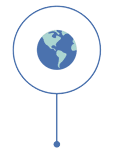In part 1 of this series, I gave a brief overview of the complexities of platform strategy and introduced regenerative thinking as a means to enhance the longevity of platforms and ecosystems. In this post, I’ll focus on ecosystem intent, the first of three areas innovators underestimate when working with platforms and ecosystems.
Part 2 — Ecosystem Intent
Most innovators underestimate the power of intent to galvanize and sustain ecosystem participation.
Ecosystem Intent Is About Aspiration and Environment
The first area that platform innovators underestimate is ecosystem intent. To define ecosystem intent, I’ll use a collaboration framework from WINfinity that depicts desired characteristics in collaborative ecosystems. A collaborative ecosystem embodies:
- An Aspiration that engages people and becomes collectively emergent
- An Environment that supports participation, affection (i.e. connection), and subsistence (i.e. core needs) and becomes a shared pathway
- Processes that support freedom (of choice), leisure, and creativity
- Tools that support belonging, learning, and security
Using this framework, ecosystem intent refers to the extent to which an ecosystem:
- Has a collectively emergent aspiration that resonates widely
- Creates an environment that attracts people, keeps them participating, and becomes a shared pathway
Ecosystem Intent in Nature
In nature, aspiration and environment can best be described by Janine Benyus’ famous quote about regenerative systems: “life creates conditions conducive to life”. In living systems, the aspiration of species is to live — to sustain their existence and thrive. The environment is the biosphere, which is composed of niches that emerge as species evolve to avoid competition and fit into a web of interactions within a habitat. In other words, a species carves out a niche for itself to find ways to coexist with other species. The more species come into existence, the more niches emerge. In this way, the aspiration is emergent and the environment (i.e. — conditions conducive to life) involves highly cooperative processes that create diversity. So, aspiration and environment in nature (i.e. the ecosystem’s intent) are about thriving through diversity and cooperation.
Ecosystem Intent in Human Systems
What does ecosystem intent look like in human systems? Let’s look at what can be learned from human ecosystems that have failed. Recent studies from Boston Consulting Group¹ and Harvard Business Review² provide some insight. The following list summarizes the top reasons ecosystems fail.
- Wrong governance choices/degree of openness (34%)
- Inability to mobilize/align participants (18%)
- Bad Execution (15%)
- Lack of compelling problem to solve (10%)
- Weak Defensibility (10%)
- Inability to achieve critical mass (8%)
- Poor incentives/value sharing (5%)
Looking at this list, most of these failure points (in bold) are influenced by aspiration (compelling problem to solve, mobilizing people, critical mass) and environment (governance, openness, incentives, value sharing). In other words, they are about the ecosystem’s intent. They demonstrate how potential participants perceive the ecosystem opportunity and the degree to which they feel they can advance a common cause or influence their future value. They include things like the ecosystem’s purpose and impact, its culture, and its level of transparency and fairness. These things are about what the ecosystem stands for and how its interactions are governed.
The Evolution of Ecosystem Intent
Now let’s look at how intent has evolved in industry as traditional companies are challenged by emerging ecosystems. Figure 2 depicts how intent is progressing within two industries, music, and retail.

In each example, the intent is driven by the question the company or ecosystem is trying to answer. Notice how the question being asked evolves from the perspective of “I” to “we” to “all of us”.
In the music industry, the intent has evolved from the “I” perspectives of Sony’s product-centric and Spotify’s convenience-centric approaches to “we” perspectives in Youtube’s peer-to-peer approach and Ujo Music’s focus on inclusion. Music Declares Emergency is an emerging group of artists concerned with music’s impact on the future of the planet. It is not a formal ecosystem, but the “all of us” intent is clear.
In retail, a similar progression is occurring. It starts with “I” intentions in Walmart’s obsession with cost and Amazon’s focus on convenience. Shopify’s focus on its peer-to-peer merchant community and the OpenBazaar protocol for inclusive marketplaces both represent a “we” perspective. Lastly, Metawear Organic has embodied the “all of us” mindset by allowing fashion businesses to bring regenerative clothing options to market with a turnkey supply chain ecosystem that regenerates ecosystems while empowering farmers and minimizing waste.
In both industries, the intent is evolving to be more aspirational (from price/convenience to inclusive/regenerative) and collective (from a product company to ecosystem).
What does it mean?
So, what do studies of ecosystem failures and observations about industry evolution tell us? They highlight how ecosystems that lack compelling intentions (i.e. — aspiration and environment) have a higher likelihood of failure. And they show us that emerging intentions are highly aspirational toward the needs of “all of us” within environments that are highly cooperative.
Now, this is not to say that ecosystems that lack a collectively emergent aspiration or highly cooperative environment cannot succeed. On the contrary, large platform ecosystems like Amazon, Facebook and Google (i.e. — FANG companies) have done precisely that. These ecosystems which were pioneered in the early days of the internet center around creating ubiquitous infrastructure. And because infrastructure tends toward consolidation at the market level, it makes it very difficult to compete with them. Although only 20% of global markets have been organized by digital platforms³, leaving many opportunities, one has to wonder whether platformizing a value chain alone will be enough to fend off the FANG companies if they decide to add the market you’re organizing to their portfolios.
The FANG dynamic makes ecosystem intent even more important because it offers innovators a way to create social capital within their ecosystems that complements the utility and convenience of frictionless value chains. By platformizing a value chain around a purpose/intent that’s collectively emergent and making the ecosystem a fair and transparent pathway for participants, innovators bring balance to the system that promotes longevity. And as I will explore further in part 3 of this series, if markets become too imbalanced toward efficiency at the expense of community health, participants typically seek other alternatives.
Emphasizing Intent in Ecosystems
So, how can human ecosystems emulate the aspiration and environment in nature’s regenerative systems? How can they aspire to something purposeful and create conditions conducive to realize that purpose? How can they create an environment that allows for individual expression while ensuring the health of the whole system?
The Yin and Yang of Ecosystems
To answer those questions, I’ll start by offering a way of thinking about human ecosystems that’s inspired by the ancient Chinese philosophy of Yin and Yang. An overview of Yin and Yang describes it as follows. Yin and yang are the forces of nature that oppose and balance each other. They are interdependent and although they are opposites, one has no meaning without the other. Yin and yang are the basic mechanisms of balance in nature. This balancing mechanism can also be observed in human ecosystems (figure 2).
In human ecosystems, platforms and communities interact in an interdependent way which I’ve defined previously as follows:
“…we refer to a platform as a business, software application, device (e.g., iPhone), network, or marketplace that enables a community to interact. An ecosystem is comprised of community participants that come together for mutual benefit, often centered around a platform.”
In human ecosystems, intent (aspiration and environment) is closely tied to the community whereas strategy is more closely tied to the platform.
Platforms — the yang of ecosystems
Platforms are the yang of ecosystems — the energetic, logical, producing, rational. Platforms are the strategies, processes, and tools that enable automated, frictionless discovery, connection, and exchange among people. They depend on communities to provide them with a purpose. They can also conflict with communities if they are used to extract value from the community, for example in the Walmart effect, where a large entity forces smaller entities out of business and erodes the health of the community.
Communities — the yin of ecosystems
Communities are the yin of ecosystems — the receptive, sensitive, nurturing, intuitive. Communities provide the aspiration and environment of ecosystems. They are embodied by common cause values and relationships that bond people together. They depend on platforms to enable discovery and connections (at scale) but can conflict or inhibit a platform from gaining traction.
Focus on community to create intent
To focus on an ecosystem’s intent, it’s essential to go through a process of deep questioning and structured inquiry to explore aspirations and establish an environment that becomes a shared pathway. Explore the following questions with your community as you embark on your ecosystem journey.
(To assist in exploring these questions, we’ve created the Ecosystem Intent toolkit which utilizes canvases, exercises and will soon incorporate examples of emerging regenerative patterns for inspiration).
What’s important and what’s possible?

By exploring this question, innovators create a foundational context that becomes an attractor and the basis for engaging with others to make the context shared and collectively emergent. Ask what’s important and what does that make possible. Then take your answer and ask why that’s important and what that makes possible. Iterate this until you arrive at your highest possibility.
With whom will you engage as a community?

Who shares your aspiration? Who benefits from your highest possibility? Does the ecosystem view participation as a process of mobilizing value chain partners or creating a community? Explore how diverse community relationships can create social capital that develops culture, attracts additional participants, and enables the aspiration to emerge collectively.
What’s your collective impact?

Think broadly about the impact your community can have by acting collectively on your shared context. What impact will the ecosystem have on the local, regional, and/or global environment in which it is embedded? This will create a more specific frame of reference and common purpose that focuses on innovation possibilities, expands ecosystem appeal, and attracts participation.
What environment will the ecosystem have?

Explore how value will flow among participants throughout the ecosystem. How can the ecosystem balance diversity and efficiency so that individuals and the whole system remain healthy? What is the ecosystem’s intent regarding who can participate and access data? Who can fund or monetize the ecosystem? Who has property and decision rights?
What’s your idea?

Most innovators start ideating before context and environment become shared and the ecosystem’s intent has coalesced. By establishing the intent related to aspiration and environment first, innovators can avoid unnecessary conflicts later. Once the aspiration and environment have coalesced, explore the preliminary opportunity space and the value/impact proposition that will form the foundation of the ecosystem.
How can collaboration make your idea more valuable?

How might expanding the idea make it more valuable? How can the ecosystem create multi-dimensional experiences that go beyond convenience to incorporate community participation, transparency, fairness, and sustainable impact? How can the ecosystem embed its value chain and experiences into larger problems to be solved that have widespread appeal?
Summary
To summarize, ecosystem intent is about aspiration and environment. In nature, aspiration is emergent and the environment is cooperative. In human systems, most new platform ecosystems fail, and those failures are heavily influenced by aspiration and environment. In industry, aspirations are evolving toward the perspective of “all of us” within an environment of cooperative ecosystems. These trends highlight the importance of balancing the role of platforms and communities within ecosystems. Lastly, to emphasize ecosystem intent, establish a collective process of inquiry within your community. Answer key questions that enable its aspirations to continuously emerge and its environment to become a shared pathway.
In part 3, I’ll share the second of the three areas platform innovators underestimate in their initiatives — ecosystem flow.
You can read Part 1 of this series here.
Thanks to Danielle Stanko and Trae Ashlie-Garen for their reviews and contributions to this story.
